Kenwyn parish church’s stained glass windows
Kenwyn church and stained glass—the background
A common misconception about stained glass in parish churches is that all the windows are in their original position and unaltered since their insertion. The story of Kenwyn’s stained glass windows shows otherwise, and is typical of the difficulties, dangers and adventures that face this fragile artistic medium. For nearly two hundred years its windows have been inserted and moved, damaged and repaired as the building itself was progressively restored, enlarged and re-ordered.
Our story starts at beginning of the nineteenth century: if there had been any earlier glass it did not survive the ravages of the Reformation and the Civil War, and there is no record of Kenwyn having any medieval glass. In most English parish churches during the Protestant seventeenth and eighteenth centuries the religious sensibilities of the times discouraged any display of imagery and colour. Kenwyn was no exception, so by the church was glazed with plain glass throughout.
Two factors dominate the story of Kenwyn’s Victorian stained glass. The first was the actual size of the parish and its population. Today the church seems to be just one of several parish churches within the suburbs of a city dominated by its cathedral. In , however, the parish of Kenwyn and Kea covered a large area of over 15,000 acres, with its two churches at the extremities of the parish. The first fifty years of the nineteenth century saw Kenwyn’s population rise from 4,017 to 10,708.1 Kea’s new church was built in a more central position in .2 With the removal in of the obstacles to new church building, new parishes were created at Chacewater, and in Truro St John’s and St George’s churches were built. The pressure for increased seating at Kenwyn was immense, and a major rebuilding commenced in . To the original medieval building, consisting of a five-bay nave and south aisle, a two-bay chancel and south chapel, and a north transept, was added a large south transept, enough to accommodate eight rows of pews. This new format was to last a mere forty years. Incidentally, one important consequence of the size of the parish’s population was the presence of a considerable number of wealthy donors who were willing to contribute to the physical and artistic heritage of the church.
The second major influence on Kenwyn’s Victorian glazing concerned the religious status of the church. The emergence of the High Church Tractarians and Ecclesiologists during the 1830s and early 1840s had a profound impact on attitudes towards the demand for stained glass windows, and in this respect, Kenwyn was one of the most prominent of the Cornish parishes. Before the formation of the Diocese of Truro in , all Cornish parishes were part of the Diocese of Exeter, and in the Exeter Diocesan Architectural Society was formed, the first after the Oxford Diocesan Architectural and Cambridge Camden Societies. It was formed to promote the study of Ecclesiastical, i.e., High Church, Architecture.3 Cornish members were always a small proportion of its total membership (in there were 17 Cornish members out of a total of 272)4 yet in the first decades Revd George James Cornish (vicar –), Revd Edward Harold Browne (vicar –) and Revd Richard Vautier (vicar –) are all listed as members.5 These decades were crucial, as the donation of memorial stained glass windows became an acceptable form of church decoration for the first time for centuries.
Obituary windows of richly painted glass serve every purpose which the pious affection of surviving relatives can desire, whilst as heightening the general effect of the church’s interior by spreading a warm religious glow we all know their value.6
To Ecclesiologists colour was a response to centuries of Protestantism.
Colour was feared as an evil spirit which they were determined to cast out.
Neither church nor nation has yet recovered from the insidious poison of this Puritan
leaven.
7
That so many of the Kenwyn clergy were members of the prestigious High Church organisation
in the Southwest committed to the promotion of stained glass is highly significant.
Related research confirms their status in these decades as ‘High Church’ or
‘Tractarian’ clergy.8
Kenwyn’s first stained glass windows—colour and light

Figure 010. The window made by Robert Beer in , originally inserted in and now in , showing the three saints present at the Transfiguration: St Peter holding the keys, St John the Evangelist with a dragon emerging from a chalice, and St James the Greater with a pilgrim’s staff and knapsack.
Having set Kenwyn’s parochial and religious context, the story of the church’s stained glass windows now commences with the insertion of the earliest stained glass window in Victorian Truro. After the restoration of , the new window was of three plain glass lights, and in was filled with stained glass by the Exeter studio of Robert Beer. The window (Figure 010)9,10, donated by Prebendary Cornish, depicted SS Peter, John the Evangelist and James the Greater. Each saint is shown with their customary attributes prominently displayed: Peter’s two keys, John’s chalice and dragon, and James’ pilgrim’s knapsack and staff. The settings are typical of designs of the mid 1840s, profoundly influenced by Pugin’s writings and his own windows manufactured by John Hardman of Birmingham. Each light has heavy borders based on medieval models, surmounted by simple Gothic canopies. The tracery consists of scroll inscriptions on foliage designs, and there are three roundels in the lower sections of the main lights. One roundel has the tau-rho symbol ⳨, and the second a fine pelican in its piety, at this time a recurrent High Church icon, and aptly placed above the High Altar. The central roundel probably had an inscription of the donor, but this was replaced in the 1980s when the chancel windows were restored.
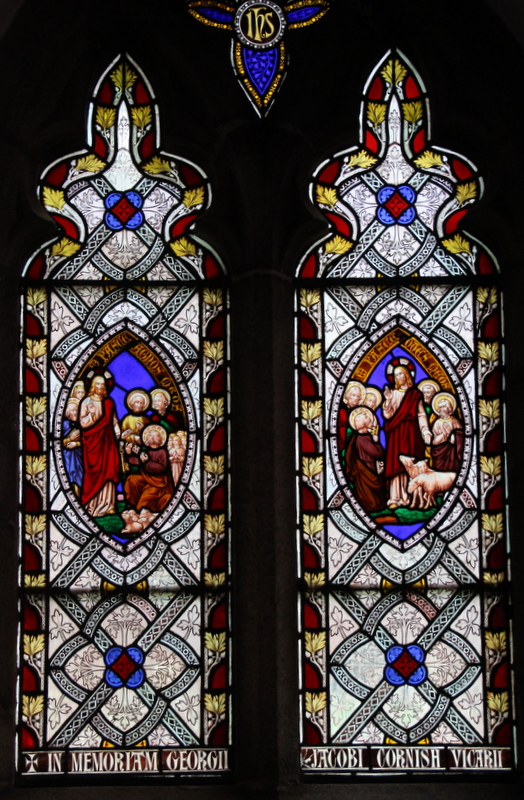
In memoriam Georgii Jacobi Cornish vicarii (In memory of George James Cornish, vicar)
Figure 020. The window made by William Wailes in , originally inserted in and now in , showing Christ’s commissions to Peter. In the left-hand light, Pasce agnos meos (Feed my lambs) and, in the right-hand light Pasce oves meos (Feed my sheep).
This window was quickly followed by two others. In the same year of , a three-light window was inserted in the window also by Robert Beer: 9,10 this was to become the first of the ‘lost stained glass windows of Kenwyn’, as explained below. A two-light window (Figure 020) in memory of Revd GJ Cornish was inserted in next to the tower in .11 This was made by William Wailes of Newcastle who, at that time, was the preferred studio of the Exeter Diocesan Architectural Society. This depicts Christ’s commission to Peter and ‘feed my lambs’. Again, the format was typical of the period’s attempt to copy medieval features such as mandorla shaped narrative panels with grisaille backgrounds, medieval-style borders and Gothic-style inscriptions. The face painting of the saints was again modelled on early medieval styles, and met with approval from the various ecclesiological societies, but the poor industrial quality of the glass used by Wailes is particularly apparent in the blue backgrounds.
Figure 025. Before the restoration.
Kenwyn’s stained glass golden age
In the church underwent a major restoration and rebuilding. There had been numerous references to the inferior quality of the workmanship of the restorations,12 and things were brought to a head in when a tower pinnacle collapsed after being struck by lightning, causing severe damage to the roof.13 Revd Richard Vautier supervised a rebuilding of the main sections of the church which was placed in the hands of the Cornish architect . The medieval tower remained unaltered, but the chancel was extended by one bay. Its original three-light east window was replaced by a new one of five lights, flanked by a single light window in the south sanctuary and a two-light window in the north sanctuary. The new window was of four lights and all the remaining windows of the nave and south aisle were remade into a standard sized three-light format. The south transept of was shortened by a bay to accommodate the new organ, whilst the north transept, always referred to as the Tregavethan aisle, had been rebuilt with the donation of the owner of Tregavethan Manor, J Ennis Vivian. The restoration caused a veritable musical chairs of stained glass window movement, with the three existing stained glass windows all taken out and moved to new positions. The chancel extension now included a new window of five lights, so the seventeen year old three-light Beer window was removed, and now reinserted in , where the first ‘lost stained glass window of Kenwyn’ had been placed only twelve years earlier. This window was now reinserted in , which meant that the two-light Cornish window that had been placed there only twelve years earlier was now reinserted into the new two-light position.15
Figure 028. Window relocations during the restoration.

Blessed be the King that cometh in the name of the Lord. Peace in heaven & glory in the highest ()
To the glory of God and in memory of William Mansel Tweedy of Alverton Truro died
Figure 030. The window made by Lavers and Barraud in , originally inserted in and now in , showing Christ’s entry into Jerusalem.
Not only were existing stained glass windows moved to new positions but, as commonly happened, the church restoration stimulated a whole raft of donations of new windows, principally in the eastern part of the church. In chronological order, they were as follows:
| Insertion | Location | Dedicatee(s) |
|---|---|---|
| William Tweedy | ||
| Edward Osler | ||
| tracery | ||
| Revd Clement Carlyon and relatives | ||
| Elizabeth Blamey | ||
| Late –early | Bishop Edward Browne | |
| John Tippet | ||
| – | John Vivian |
Figure 040. After the – insertions.
These new windows form a fascinating example of the way tastes in artistic style had changed in the twenty years since the first Victorian stained glass in the 1840s. The new memorial window (Figure 030) by Lavers and Barraud in 16 for William Mansel Tweedy is a good example. Gone were the small narrative panels set in grisaille background of Wailes’ Cornish window; Christ’s entry into Jerusalem now boldly spans all three lights, with richly coloured motifs replacing architectural canopies. The ‘Hosanna’ angels are placed almost as spectators in an overlooking window, whilst the grisaille backgrounds are now restricted solely to the lower predella panels. The dedicatee was a Truro banker who provided the funds for the building of St Paul’s church on Tregolls Road in . A bill in the records of the restoration24 probably refers to this window.

To the glory of God and in memory of Harriet Carlyon died aged 74 years, Eliza Carlyon died aged 81 years, Clement Carlyon died aged 87 years, Mary Carlyon died aged 90 years, Anne Carlyon died aged 82 years.
Figure 050. The window made by Alexander Gibbs in , in memory of members of the Carlyon family.
This change in taste for colour and artistic style is best seen in the five-light window
in the new ,
made by the Alexander Gibbs studio in ,
with an extravagant palette of colours and dazzling mosaic effect.
The east window is a triumph of blues and reds and golds with medallions set in patterns.
17
The sixteen sections in the tracery are filled with an Agnus Dei,
praying and scroll-carrying angels, and various emblems such as the Star of David and Alpha and Omega.
In addition, there are smaller floral motifs which echo the highly coloured main light backgrounds.
In the main lights, these mosaic backgrounds surround various small narrative panels illustrating
scenes of the Life and Ministry surrounding a central Christ Ascension scene of Christ in a mandorla
with nine apostles and the Virgin Mary. The window is a memorial to various members of
the Carlyon family:18
Edward Trewbody Carlyon was a church warden at the time of the restoration.19
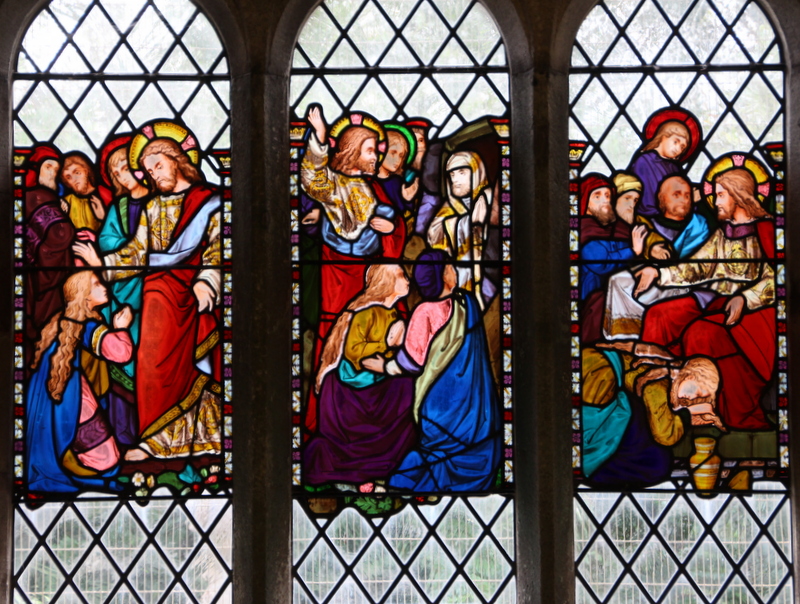
In memory of John Tippet 13 years churchwarden of this parish died aged 64
Figure 060. made by Alexander Gibbs in , in memory of John Tippet, a former churchwarden, showing (left) Christ on the way to Bethany, (centre) the Raising of Lazarus and (right) the washing and anointing of Christ’s feet.

Figure 070. The tracery of .
The rich colouring of the Carlyon window was continued in two further Gibbs windows in the chancel opposite the Tweedy window. (Figure 060) contains three scenes of the life of Christ—Mary Magdalene before Christ and the apostles, the raising of Lazarus, and Mary washing Christ’s feet with her hair. There are far too many figures in these scenes, and the whole effect is congested and confused. The trefoil tracery (Figure 070) continues the busy colours in a pattern of stylized plant motifs. The window is in memory of the churchwarden John Tippet and was inserted in 20
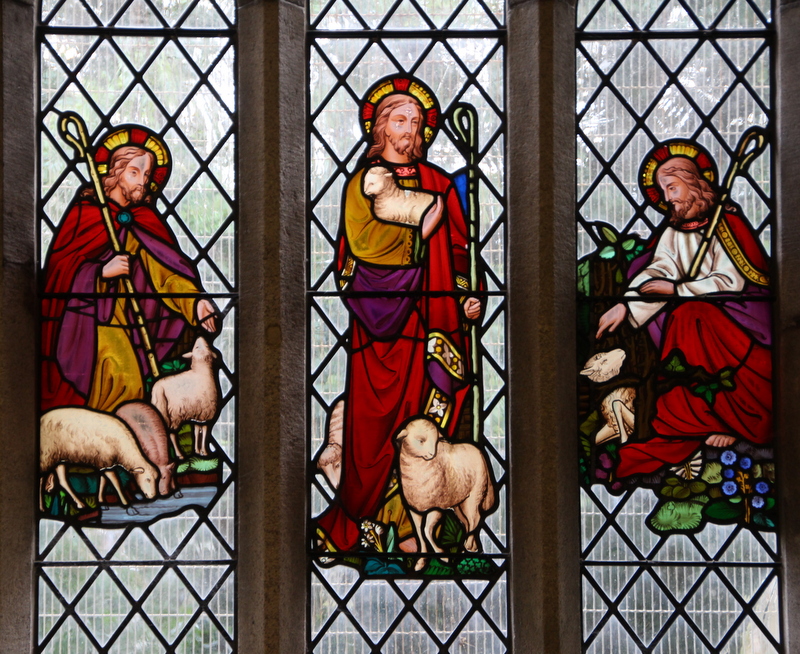
To the glory of God and in affectionate memory of Elizabeth Blamey
Figure 080.
made by Alexander Gibbs in ,
in memory of Elizabeth Blamey, showing three scenes of Christ as the Good Shepherd and illustrating
:
The Lord is my shepherd; I shall not want.
He maketh me to lie down in green pastures: he leadeth me beside the still waters.
This window was originally given by Joel Blamey in memory of his wife, but the present-day
inscription, probably written when the original background and borders were removed (see below)
includes Joel Blamey as a dedicatee.
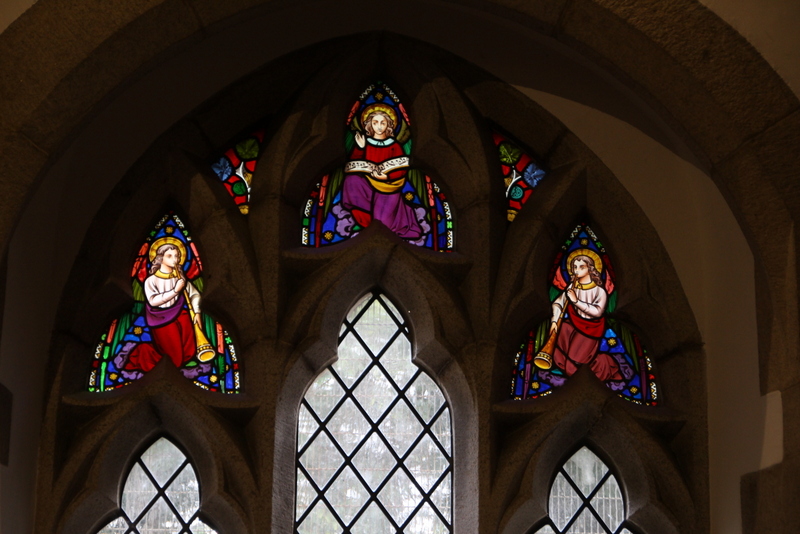
Figure 090. The tracery of . At the top an angel holds a book of music, while the angels below blow trumpets.
The last Gibbs window is , (Figure 080) where three depictions of Christ as the Good Shepherd are much more artistically successful, with a single figure surrounded by sheep and lambs in each light. The tracery (Figure 090) is also much simpler with three angels—one holding a book of music and two blowing very pre-Raphaelite long trumpets. The window was given by Joel Blamey in memory of his wife Elizabeth and was inserted in .21
A further three-light window with tracery was inserted in the post-restoration period in the chancel at between the Tweedy and Cornish windows. This is the second ‘lost stained glass window of Kenwyn’, dedicated to Edward Osler, editor of the Royal Cornwall Gazette, which might explain the lavish coverage of Kenwyn church in the press. It was another Gibbs window, with the subjects of the Transfiguration, and inserted in .22
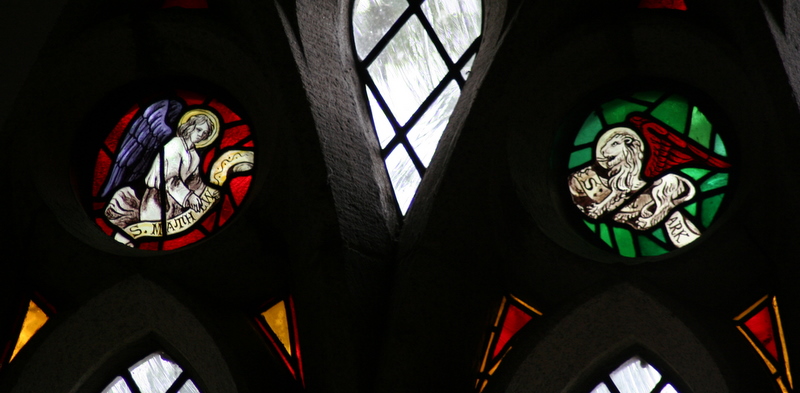
Figure 100. tracery left: the emblems of SS Matthew and Mark.
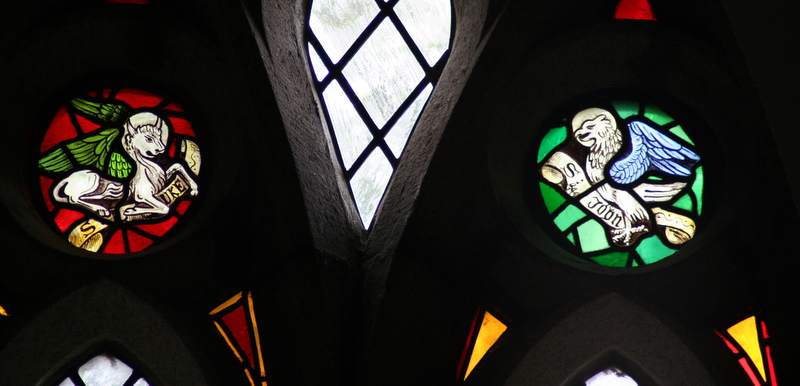
Figure 110. tracery right: the emblems of SS Luke and John.
As part of the restoration, the shortened south transept was completely filled by the organ in . Consequently, the transept’s east and west windows were left as plain glass, as were the main sections of the new four-light window. Four roundels in its tracery (Figures 100 and 110) were, however, filled at this time with stained glass of the emblems of the four evangelists as this was the only part of the window visible above the organ. The emblems were intended for the new church at Old Kea but presented to Kenwyn by in .23

In memory of John Ennis Vivian Esq erected by Major Quintus Vivian of Tregavethan Manor.
Figure 120. showing Christ as the Good Shepherd in the centre light, with the arms of Vivian in the left-hand light and, in the right-hand light, probably a crest of Vivian.
The north transept (the Tregavethan aisle) was rebuilt around the same time as the restoration of the main church, and the central panel of its three-light window (Figure 120) was subsequently filled with a Good Shepherd given by Major Quintus Vivian in memory of J Ennis Vivian. This is in the severe Gothic style of the earlier decades and is obviously made by a quality studio. The outer lights both contain roundels of Vivian arms set and crest in rose motif diamond quarries. On stylistic grounds it is attributed to the prestigious London firm of Lavers & Barraud. The date of insertion is unknown, but is likely to be between the death of the dedicatee, , and the death of the donor, .

Figure 130. Royal arms, arms of the Bishop of Exeter, and the arms of former vicars, a curate and churchwarden of Kenwyn.
The final window of this golden age of Kenwyn’s stained glass was the insertion in – of (Figure 130)14,25 This is an armorial window with the royal arms in the tracery, and the three main lights filled with the arms of past and present vicars of Kenwyn. The arms of Revd Vautier (the vicar of Kenwyn and Kea at the time of insertion, and possibly the donor of the window) are in the centre, and the window celebrated the appointment of Edward Harold Browne (Vautier’s immediate predecessor as vicar of Kenwyn and Kea) as Bishop of Ely. Some of the painted details in the arms are delightfully quirky (Figure 140). The window may have been another product of the William Wailes studio.

Figure 140. . The arms of Richard Milles, vicar –. The arms of Milles of Suffolk are argent, a chevron between three millrinds sable, and the crest is a hare sejant proper in the mouth three ears of wheat or () The second wife of Richard Milles was Susanna Horndon, whom he married on at St Dominic, Cornwall. The arms of Horndon of Cornwall are argent a heron volant in fess azure membered or between three escallops sable ().
The remainder of the Victorian age—vandalism and vicissitudes
So, within a very short period of five years, Kenwyn now had eleven stained glass windows. All the windows of the Chancel (except for the single-light ), the transepts and the west end had been filled with memorial windows, just in time for the most shocking episode in the story of Kenwyn’s stained glass. Two of Kenwyn’s windows suffered severe vandalism on –.
Malicious Destruction of Kenwyn Church Windows.—A most disgraceful outrage has been committed at Kenwyn Church, several panes of stained glass having been maliciously broken in the beautiful eastern [] and western [] windows. The work of destruction is believed to have been perpetrated late on Sunday evening, or early on Monday morning, and from the manner in which the protecting trellis had been lifted at several places it is evident that the act was not committed without premeditation and perseverance. This is one of the grossest and most detestable pieces of vandalism which we have heard of for a long time, and we sincerely hope the ruffian may be discovered, though we fear adequate punishment cannot be inflicted upon him.26
The tone of the account conveys the outraged feelings of the vicar and congregation but, interestingly, does not give any details of the nature of the damage, possibly to avoid any further ‘copy-cat’ attacks. Evidence shows that the faces of the three saints in the Beer window were destroyed, and one wonders what the motive was in targeting the faces only. The fact is that the newly painted replacement faces do not fit comfortably with the rest of the figures. These were painted by Wailes, and their style is typical of that of the studio’s chief designer James Mein.
Reference has already been made to the second Beer window,
now in the , as the first of the ‘lost windows of Kenwyn’.
It is unclear whether the vandal attack destroyed any part of the main lights, whose
decorative patterns
were still in place in the 1970s.27
The tracery, however, suffered badly and was completely replaced with
some fine evangelistic emblems in the best style of
William Wailes. Whether this was the same iconography as originally is unknown.
The replacement sections to both Beer windows were done by the same studio at the same time.
Happily, this was the only vandalism that the church suffered in the nineteenth century. The pressure on congregational space at Kenwyn was relieved during this period with the opening of four mission churches of All Saints at Highertown in , St Faith at Shortlanesend, Shortlanesend and Tregavethan, whilst St Paul’s, Tregolls Road was enlarged in . We must not forget that the consecration of Truro cathedral in in effect reduced Kenwyn to one of several suburban parish churches.
‘Re-ordering’ was to have a serious impact on Kenwyn’s windows in , when the decision was made to completely rebuild the organ and move it from the south transept to the east end of the south aisle.28 This effectively blocked the view of the Beer window and the two Gibbs windows in the aisle’s south wall, whilst revealing the plain glass in the south transept’s three windows, so undoing much of the impact of the earlier glazing. It was symptomatic of a change in attitudes in Victorian times when musical priorities overtook those of aesthetics to such a degree that windows that were only thirty years old were hidden from view.
The 20th century—something old, something new

His mercy is on them that fear him ().
In loving memory of John Rundle Cornish, Bishop of S: German’s [sic], and Vicar of this Parish, and of Constance Eliza his wife:
Figure 150. showing the Virgin and Child.
Unlike in many parish churches, no First World War memorial windows were inserted in Kenwyn. The small single-light location was filled with a stained glass window (Figure 150) in .29 This portrayed a Virgin and Child, made by the studio of Percy Bacon, and was a memorial to Revd John Rundle Cornish, former vicar of Kenwyn (–) and Bishop of St Germans, and his wife Constance Eliza Cornish. The style is typical of the kind of windows that this firm had been making since the 1890s and features a particularly clumsy architectural plinth and fussy background. It is an unobtrusive window, sadly reflecting the extreme conservatism of so many English stained glass windows of the early twentieth century, at a time when exciting Arts & Crafts windows were being inserted elsewhere in Cornwall.

I was sick and ye visited me ()
Let this be a Memorial of the Rev. Charles Burgess, whose love embraced the people of this Parish and the stones of this Church. He was born and passed over . Given by his Son and Daughter-in-law and a few friends.
Figure 160. showing St Luke.
In , the single-light
window was finally filled with a memorial window (Figure 160) donated by his relatives and friends in
memory of Revd Charles Burgess. This shows St Luke holding the text I was sick and ye visited me
()
and the face of the saint is a photographic likeness of Revd Burgess, a common feature of the times.
Figure 165. Window relocations during the extension.
Just four years later yet more ‘stained-glass musical chairs’ occurred when the north chancel was extended to accommodate a new organ chamber. This occupied the second and third bays, which already held the Osler and Tweedy memorial windows. The Osler window from was sealed behind the organ (as ) and has remained totally hidden from view for the last eighty years.30 At the same time the Tweedy memorial window, which was in the , was moved to the position, where it is seen to great advantage. The transfer of the organ to its new home meant that the Beer, Tippet and Blamey memorial windows in the chancel south aisle were back in full view after forty years hidden behind the organ. This aisle was now designated as the Chapel of the Transfiguration and dedicated by Bishop Frere in .31
After there was a phase when the backgrounds and borders of Victorian stained glass were removed, leaving the main narrative scenes or figures ‘floating’ in plain glass. Obviously, this made interiors less dark, but the integrity of the original designs was fatally compromised. This was the fate of the two Gibbs windows (Tippet and Blamey) in the south aisle and was perpetrated between and . The light showing the washing of Christ’s feet was a repeat use of the cartoon from an window in St Nicholas, Wickham, in Hampshire, where the background to the scene remains and shows what has been lost.
The two areas of Kenwyn church that were never glazed with stained glass were the two windows of the north nave and the two on either side of the porch in the south aisle. Throughout this period the plain glass inserted in the restoration had been retained,32 but it was in a serious state of decay even by the 1930s. Eventually, in the 1970s, all these windows were restored using superior quality crown glass. These were restored by Wippells of Exeter in memory of the previous incumbent Revd Glyn Malcolm Calder, and marked with discreet inscriptions. The window was also reglazed by Wippells at the same time. It still retained the tracery evangelist emblems from by Wailes, but the arms of the Diocese of both Exeter and Truro were inserted in the central light. It seems from the original leading patterns that the main lights had borders which perhaps had previously been coloured glass following the vandalism of .
Further restoration took place on the main Carlyon window in the in the late 1980s when re-leading, cleaning and protection were all major priorities. This was successful, but in time the polycarbonate that was used as external protection has darkened considerably, and the main lights are seriously bowed.
Into the 21st century

Remembering Alan Carveth –
Remembering Gwen Carveth –
Remembering Len Carveth –
Figure 170. centre light: inscriptions and the emblem of the Truro Diocesan Guild of Ringers.
The window always had plain quarries, but after two of the diamond quarries were etched with inscriptions in memory of the parents of Alan Carveth, churchwarden and Captain of the bellringers. In two more were made by Minster Glass in memory of Alan himself with the Truro Diocesan Guild of Ringers’ badge (Figure 170). These discreet memorial inscriptions show how memorial tastes have changed from the Victorian times.
Lastly, in , the St Luke window (with the likeness of the dedicatee Revd Charles Burgess) in the was vandalised. By coincidence, like the Beer window in , only the head of the saint was destroyed. Luckily there was a detailed photograph of the window which Andrew Johnson of Exeter was able to copy most successfully, showing yet once again how essential it is to have a detailed photographic record of all windows in case of damage through vandalism or natural causes.
The end of the story?
The changes that have occurred to Kenwyn’s windows over the past one hundred and seventy years are in many ways a microcosm of the story of stained glass in all parish churches. There is no evidence of any master plan in the subjects or iconography in the windows, and the subject-matter seems to have been the choice of the donors.
The story starts when stained glass was shunned as an element in church decoration, only to be revived with enthusiasm to reflect High Church attitudes and the wish to commemorate relatives, friends and the clergy. In Kenwyn church, windows have appeared and disappeared from view as other parts of the church’s worship have gained precedence over aesthetic considerations. They have been repaired and moved around the building as additions and restoration to the fabric have taken place. They have been altered to reflect changes in artistic tastes. And, of course, the fragility of this art form is always prey to both mindless and wilful vandalism and to the ravages of time and weather. This is all part of the story of Kenwyn’s windows. For much of the twentieth century the windows were disparagingly linked with the Victorian restorations and generally given a bad press.33 Hopefully they can now be better understood and valued as part of the church’s heritage in decades to come.
References
- .
- Kea’s ‘new church’ was built in and replaced in by the current church designed by G Fellowes Prynne.
- Transactions of the Exeter Diocesan Architectural Society, , Vol 2.
- Ibid.
- Transactions of the Exeter Diocesan Architectural Society, , Vol 2, pp 201–210.
- Revd John Armstrong, Monuments dated , Transactions of the Exeter Diocesan Architectural Society. , Vol 1, p 11.
- William White, Colour, its use and abuse. Transactions of the Exeter Diocesan Architectural Society. , Part , Vol 1, p 198.
- .
-
The east window in the south aisle [] has tracery very similar to that in the chancel; but the glass with the exception of the head is of a plain diaper pattern,
The Ecclesiologist No , September 1845, p 241. Jim Cheshire, Early Victorian stained glass, University of Exeter Ph.D. thesis, , p 120. - .
- .
-
,
principles of bad taste and false economy prevailed,
slovenly and false economy of the builders of .
- , a very detailed and dramatic account!
- Possibly manufactured by William Wailes. Dedicatee Revd Harold Browne, vicar of Kenwyn on appointment as Bishop of Ely. Notes - ,
- In this form of nomenclature, windows are always numbered from the east.
- This window is now in position.
- Harriet, Elizabeth, Clement, Mary and Anne Carlyon.
- .
- .
- .
-
—
certain of his friends erected this memorial.
-
emblems given to Old Kea by Miss Monck of
Caversham Park
(probably Coley Park) near Reading. -
Receipt (undated) from Lavers & Barraud, Endell Street, Bloomsbury WC for £7/12/0.
Ask your churchwardens to send us the above, as it has been long unpaid.
- The church guide dates this window as , the same date as the Wailes south aisle west window. But the Revd Vautier did not become vicar until , and neither of these dates would explain the bishop’s mitre above the arms of Revd Harold Browne, a reference to his elevation to become Bishop of Ely in .
- .
- Oral evidence from Edward Carlyon (Churchwarden, 1990s).
- . Organ rebuilt by Brewer & Co., Truro.
- .
-
RF Wheatley in Gill, op. cit., p 20.
The Osler window was
utilized to light the new organ chamber
! - Gill, op. cit., p 21.
-
.
Estimate dated
from NR Glasson
for reglazing the old windows of Kenwyn Church to match the new ones
£11/5/0 for glass and £4/5/0 for saddlebars and stanchions. - As in the first edition of Pevsner’s Buildings of England—Cornwall, , London, Penguin Books, and Charles Henderson in Gill, op. cit., p 28.